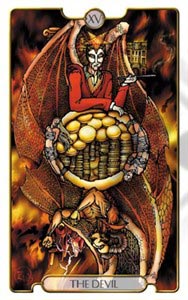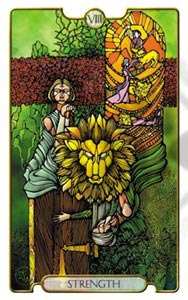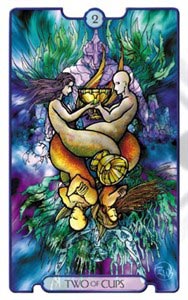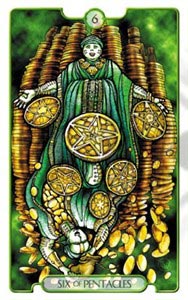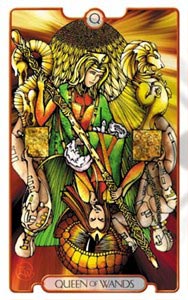Revelations Tarot Deck Review
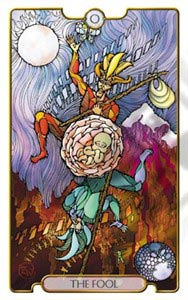
The Revelations Tarot has illuminated artwork with a swirling effect reminiscent of stained glass. Its art is also double-ended, with an upright and reversed image merging in the center of the card.
Deck Type: Tarot Deck Cards: 78
Creators: Zach Wong
Publisher: Llewellyn 2005
Retailers
See Price at Amazon.comSee Price at Amazon.co.uk
See Price at Amazon.ca
Revelations Tarot Review by Bonnie Cehovet
Reviewing this deck (and its companion book) has been one of the most fun projects of the year for me. I wasn't too sure about this at first, because I was asked to review the book before the deck came out. I did find that a bit difficult, but I loved the book, and am incredibly excited about the deck!
Zach Wong grew up in Malaysia, where he studied Western and Asian mythology. He now lives in Australia, where he works in illustration/graphic design. This gentleman is incredibly talented, has a vivid imagination, and has gifted the world with a deck that you really need to pay attention to. It follows the 'rules", then goes way beyond them!
In creating this deck, Wong was interested in the myriad levels of meaning that each of the cards have, and in portraying the cards in a manner that would lend itself to multiple levels of interpretation. One of the ways in which he managed to do this was to place back to back illustrations on each card - the upright version lends itself to a certain meaning, and the reversed version lends itself to another meaning.
In the Major Arcana, the archetypal journey, we find masks on each of the figures. I found this incredibly cool (but then, I am also contemplating putting theater masks on my living room wall!)! Wong did the Major Arcana in a style that he terms similar to stained glass, with each image representing a lesson to be learned, a being to be studied, or a situation. The mask acts to bring in the "human" element. Wong sees the Minor Arcana as "lesser" versions of the lessons from the Major Arcana.
This is a traditional 78 card deck, which comes with a companion book and a black organdy bag. There are two extra cards, which carry the templates for the Horoscope Spread and the Seven Days Spread. The cards are approximately 2 3/4" by 4 3/4", a nice size for smaller hands. They are on good quality, glossy cardstock. The backs of the cards are dark blue, with black sworls running throughout in a theme that strongly resembles a lemnescate. It would not be possible to tell if the card had been drawn in the upright or the reversed position.
The card faces have a 1/4" white border, with the card number at the top in black against a white background, with the card title in the bottom, in black against a white background. One of the most interesting cards for me is Death. in the upright position, we see the Goddess Kali dancing within a skull. Reversed, we see the transformative quality of Death in the pose of a newborn baby entwined in bloody tendrils - hope emerging from the worst of situations.
The Hermit, being one of my birth cards, has always been a favorite with me, in any deck. In the upright version, we see a Druid holding a lamp with a six-rayed star in front of him. He represents Knowledge and tradition. The upright version is very much at peace, the reversed version highly chaotic - someone running from their demons.
The Magician is a fascinating card. Against a bright green background, we see a masked, red robed figure, with a lemnescate hovering over his head, his staff held straight and upright. In the upper left hand corner we see a white dove. The reversed figure wears purple robes, and holds a crooked staff in his hand (indicating the haphazard nature of his mind and his powers).
The Ace of Cups carries a very powerful image - against a background of blue and purple sworls, we see an ornate golden cup overflowing. Looking closely at the top of the stem, on the right hand side, it looks to me like the figure of a person with their arms held over them, helping to bear the weight of the cup. This is one card that the reversed images, which is supposed to show an empty cup, does not work for me.
The Five of Pentacles is quite an eye-catching card - against a royal purple background we see five pentacles forming a circle. In the upright position, we see a figure reclining over the top pentacle, one hand held out, as if asking for help. In the reverse position, we see another figure, this time kneeling on one pentacle, with one hand bracing themselves on another pentacle. Their right arm is held over their left shoulder, and they are looking to the left and up. Neither figure appears to be very happy, and they both have the appearance of low energy.
The Queen of Pentacles is another figure that we see against a green background. In the upright position, she appears to be drawing inward, and seems to be at peace with her environment. She is flanked by two green pillars, and is crowned with red roses. The reverse Queen, quite frankly, appears to have imbibed a bit and be enjoying herself way to much! She pays attention to herself and her own needs, rather than to the needs of those around her.
The colors in this deck have great depth - whether they are meant to be dark or light. The style is very much fantasy, but the meanings come across if one pays attention to the symbols within the card. This would not necessarily be a deck for beginners, but it certainly is a deck that lends itself to both readings and meditation, and could very well be used in ritual work. It is an excellent deck to expand your Tarot horizons with!
Revelations Tarot Review by Sandra A. Thomson
Some of us in the Tarot world have never met a deck we didn't like. Zach Wong, on the other hand, couldn't find a single deck that spoke to him, so he created his own, a deck where each card had a meaning that resonated with him as he pursued his personal journey of self discovery.
Wong, who has studied mythology, and works in illustration and graphic design, drew each Major Arcana "character" wearing a mask. He believes that this acts as a representation of a human relationship as when mythical gods stand in human form "to ease our comprehension of the messages they deliver." It doesn't work for me, and, instead, some of my usually favorite cards simply come across as grotesque or uninteresting.
Not that the cards are unattractive. They are beautifully and vibrantly colored with backgrounds of swirling lines and unusual patterns. You likely will have to spend some time examing each illustration to see all its tiny details. The Time spend is worth the effort to fully appreciate the illustration and to develop your own reaction to it.
When each Major Arcana card is reversed, a different masked figure and design appears. This was somewhat disconcerting to me at first, as I pondered whether to respond to the entire card illustration or only to the half that was upright. I finally realized that viewing the card in its entirety forces me to keep alive the polarities that pertain to any given card. So, while the upright card speaks of what's actively operating within me today—or at least is more obvious—the double illustration reminds me that, at the same time, the reverse or polarity also remains potentially active in my life—at the flip of a card, doncha know. That makes this a deck to spend a lifetime with, probing for the unrealized.
Wong's companion book contains a description of the characteristics of both the upright and the reversed figure of the Major Arcana, plus an explanation of some of the images and symbolism. The same sections apply to the Minor Arcana cards, but here the "characters" themselves are not defined. Rather, Wong mostly gives a meaning for the card.
Frankly, I find many of his meanings for upright cards not that different, i.e., The Fool symbolizes "the free spirit within," while The High Priestess represents "the voice inside us that calls us to heed our intuition."
It is in his reversed definitions where I think Wong's writing is most interesting, creative, and even poetic at times. For instance, the reverse of The Empress suggests "someone lost in the wilderness of his or her own self.. Projects are started in vain, canvases remain blank, and the home feels more like a hollow vessel that is barely warm." The reverse of The Hierophant represents someone "who would be viewed as eccentric and unorthodox." Reading Wong's reversed meanings may help you understand reversed meanings for your other decks as well.
The final chapter on spreads contains four ho-hum spreads: Past, Present, Future; Four elements; Seven Days; and The Horoscope Spread. The suggested questions to apply are mostly of a fortune-telling type: "What should I do about my current job?" "What will become of my investments in my neighbor's joint venture?" Here is where Zach Wong could definitely use some help, as well as Lewellyn for condoning such shallowness.
Revelations Tarot Review by Kate Hill
Zach Wong had difficulty in finding ‘the one’, a special Tarot deck for his own readings. None of the existing decks spoke to him, so as part of his journey of self-discovery, he decided to create his own. Formerly known as the Adflatus Tarot, his work has now been published by Llewellyn under the title of the Revelations Tarot.
The Revelations Tarot takes its structure from the Rider-Waite (the suits are standard Cups, Swords, Wands, Pentacles with courts of Page, Knight, Queen and King) but has an innovation -- fully reversible cards. These cards are double-ended, each end with a different design that meet and blend in the centre. Rather than seeing an upside-down image when the card is reversed, with this deck you see a correctly-oriented image that pictorially illustrates the reversed meaning. The result is quite busy, as there’s a lot of strong colour and outlined detail packed into each card, but the skill involved in combining the two designs into a single card opposite is impressive.
The faces of the major arcana have ‘masks’, or lines breaking them up into sections: “The mask is merely representation of a ‘human’ relation, similar to that of the mythical gods who stand in human form amongst us to ease our comprehension of the messages they deliver.” I liked the Lovers -the upright end is a spiritual-appearing pair of lovers touching hands, overseen by a white-winged angel. The reversed end has a more sexual couple in an embrace with a red-clad, more reptilian looking angel overhead. And Death, with the multi-armed Hindu goddess Kali at the top, and a baby ‘amongst the bloody tendrils’ representing rebirth at the base.
The minor arcana are often androgynous and inhabit a strange universe that is part-fantasy, with mermaids in the Cups, part-futuristic in the Swords and Wands, and here and there reminiscent of stained glass. I thought the Pentacles cards worked particularly well with the theme, with the two ends complementing each other without unduly distracting from each other. The backs of the cards are, naturally, reversible, with purple swirls and a cross-like design in the centre.
I don’t use reversals myself, mainly as I prefer to see the image as it was designed, rather than an upside-down version that doesn’t convey any new meaning. Zach’s deck does remove this objection to using reversals, though I’m still not keen on the large number of more negative interpretations reversals seem to add to a reading. Life is not always pleasant, of course, but it seems rather bleaker with that many confronting or warning cards appearing, especially as the Revelations Tarot presents them with a slightly acid edge in its fractured art.
The companion book is pretty basic but conversely does not have a lot of information for the beginner - there’s nothing to do with Tarot’s history or background or how to read the cards. The major focus is on the card explanations which include image and symbolism and divinatory meanings (appropriately, the reversed meanings are just as lengthy as the upright meanings). A few unoriginal spreads follow, the inclusion of which I find a little baffling - they are standard Past/Present/Future and Horoscope type spreads; surely something the reader past novice level would have encountered before.
Overall, the Revelations Tarot is not a beginner deck, given the significant changes to imagery in order to incorporate the reversed designs. I’d recommend it as a deck for the intermediate or experienced reader, who likes to use reversals and are looking for a new perspective on the Tarot’s upright and reversed archetypes.
Complete Details of Revelations Tarot
Also known as Adflatus Tarot
Creators: Zach WongPublisher: Llewellyn 2005
Deck Type: Tarot Deck
Cards: 78
Major Arcana: 22
Minor Arcana: 56
Deck Tradition: Rider-Waite-Smith
Suits: Cups, Swords, Wands, Pentacles
Court Cards: Page, Knight, Queen, King
Major Titles: The Fool, The Magician, The High Priestess, The Empress, The Emperor, The Hierophant, The Lovers, The Chariot, Strength, The Hermit, Wheel of Fortune, Justice, The Hanged Man, Death, Temperance, The Devil, The Tower, The Star, The Moon, The Sun, Judgement, The World
The Fool is 0
Strength is 8
Justice is 11
Card Size: 2.75 x 4.63 in. = 6.99cm x 11.75cm
Card Language: English
Card Back: Reversible
Back Design: Swirling hues of purple
Companion Material: Companion book.
Rating: 16/20 or
Similar Decks to Revelations Tarot
Category: Available Tarot Decks, Double-Ended Tarot Decks< Previous Deck · Back to Top · Next Deck >
Home > Tarot Reviews > Revelations Tarot Review

